ISYS628 Business Process Modelling - Birkbeck University Case Study
VerifiedAdded on 2023/06/04
|13
|2857
|359
Case Study
AI Summary
This assignment presents a case study solution focusing on Business Process Modelling at Birkbeck University of London, addressing challenges, objectives, and improvements related to quality management. It explores the implementation of a business process management model for analyzing and controlling business processes. The solution discusses the discovery of processes, improvements achieved, and the rationale behind Business Process Modelling, including its role in regulatory documentation, risk management, organizational changes, functional cost analysis, and automation. The stages of business process modeling, such as identification, data collection, analysis, improvement introduction, and implementation control, are also detailed. Furthermore, the document covers business process models, principles of modeling, types of business process modeling, and various notations, including UML, IDEF, and BPMN. It concludes with insights into Business Process Optimization (BPO) and the importance of modeling in analyzing the state of an enterprise.
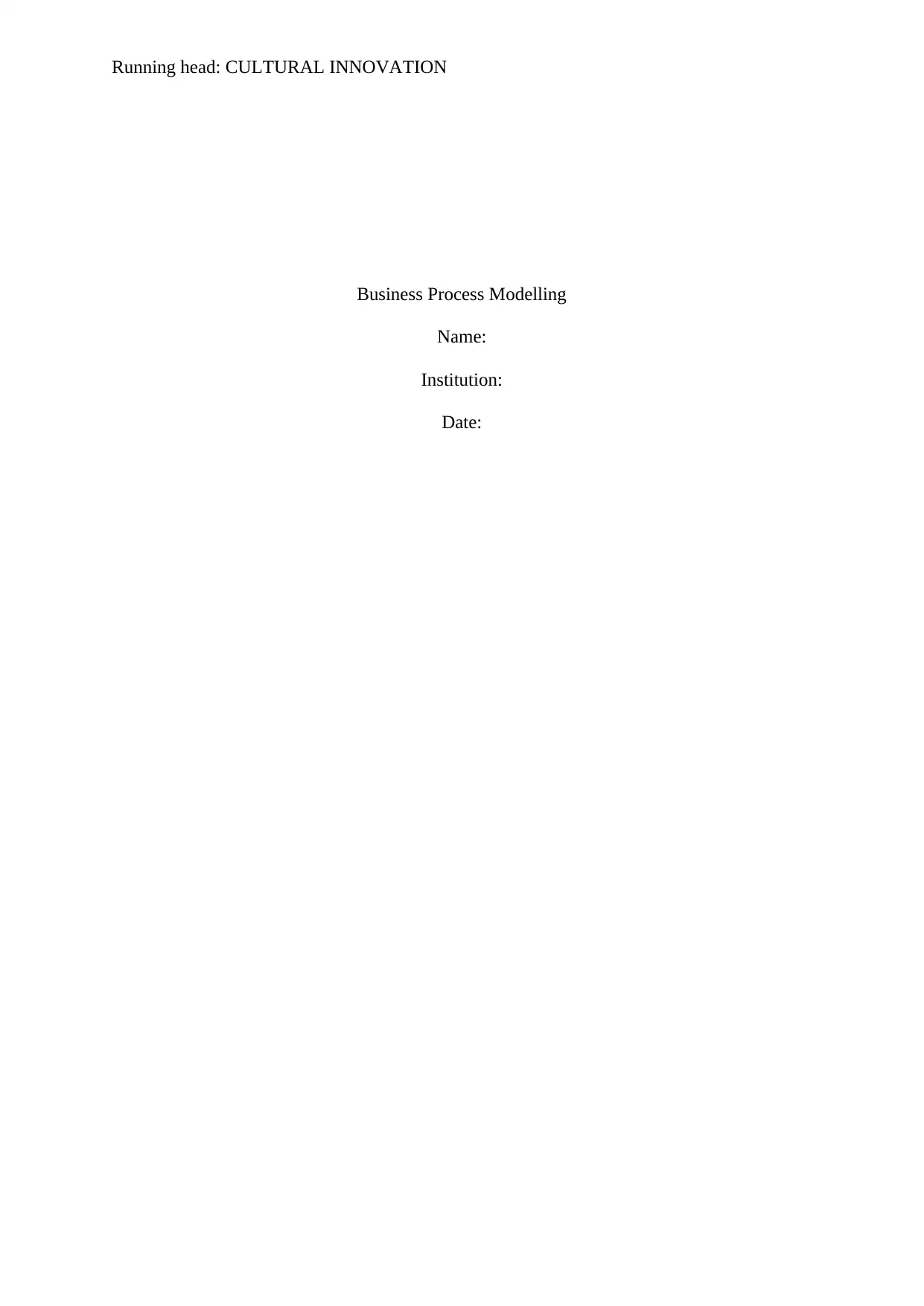
Running head: CULTURAL INNOVATION
Business Process Modelling
Name:
Institution:
Date:
Business Process Modelling
Name:
Institution:
Date:
Paraphrase This Document
Need a fresh take? Get an instant paraphrase of this document with our AI Paraphraser
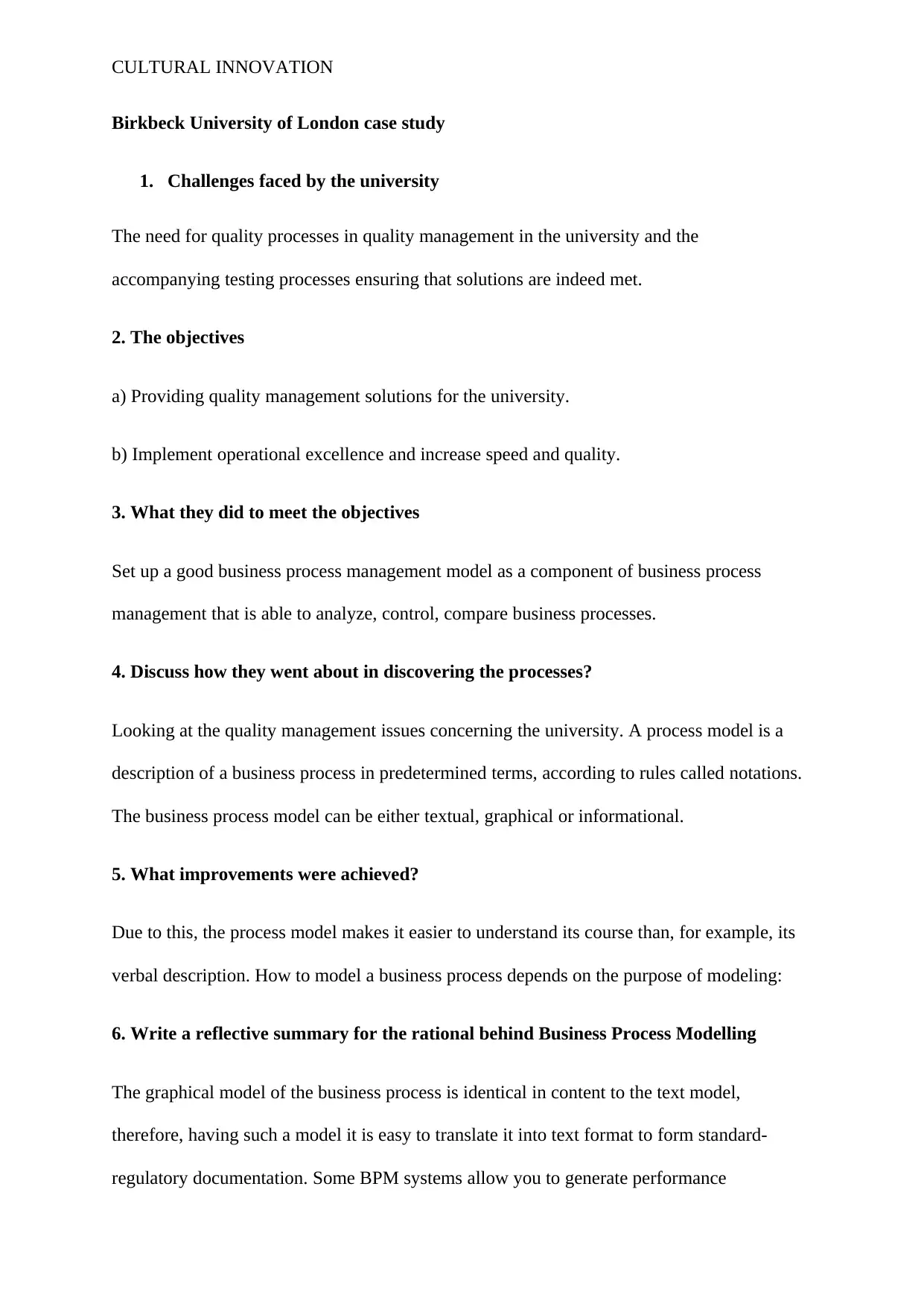
CULTURAL INNOVATION
Birkbeck University of London case study
1. Challenges faced by the university
The need for quality processes in quality management in the university and the
accompanying testing processes ensuring that solutions are indeed met.
2. The objectives
a) Providing quality management solutions for the university.
b) Implement operational excellence and increase speed and quality.
3. What they did to meet the objectives
Set up a good business process management model as a component of business process
management that is able to analyze, control, compare business processes.
4. Discuss how they went about in discovering the processes?
Looking at the quality management issues concerning the university. A process model is a
description of a business process in predetermined terms, according to rules called notations.
The business process model can be either textual, graphical or informational.
5. What improvements were achieved?
Due to this, the process model makes it easier to understand its course than, for example, its
verbal description. How to model a business process depends on the purpose of modeling:
6. Write a reflective summary for the rational behind Business Process Modelling
The graphical model of the business process is identical in content to the text model,
therefore, having such a model it is easy to translate it into text format to form standard-
regulatory documentation. Some BPM systems allow you to generate performance
Birkbeck University of London case study
1. Challenges faced by the university
The need for quality processes in quality management in the university and the
accompanying testing processes ensuring that solutions are indeed met.
2. The objectives
a) Providing quality management solutions for the university.
b) Implement operational excellence and increase speed and quality.
3. What they did to meet the objectives
Set up a good business process management model as a component of business process
management that is able to analyze, control, compare business processes.
4. Discuss how they went about in discovering the processes?
Looking at the quality management issues concerning the university. A process model is a
description of a business process in predetermined terms, according to rules called notations.
The business process model can be either textual, graphical or informational.
5. What improvements were achieved?
Due to this, the process model makes it easier to understand its course than, for example, its
verbal description. How to model a business process depends on the purpose of modeling:
6. Write a reflective summary for the rational behind Business Process Modelling
The graphical model of the business process is identical in content to the text model,
therefore, having such a model it is easy to translate it into text format to form standard-
regulatory documentation. Some BPM systems allow you to generate performance
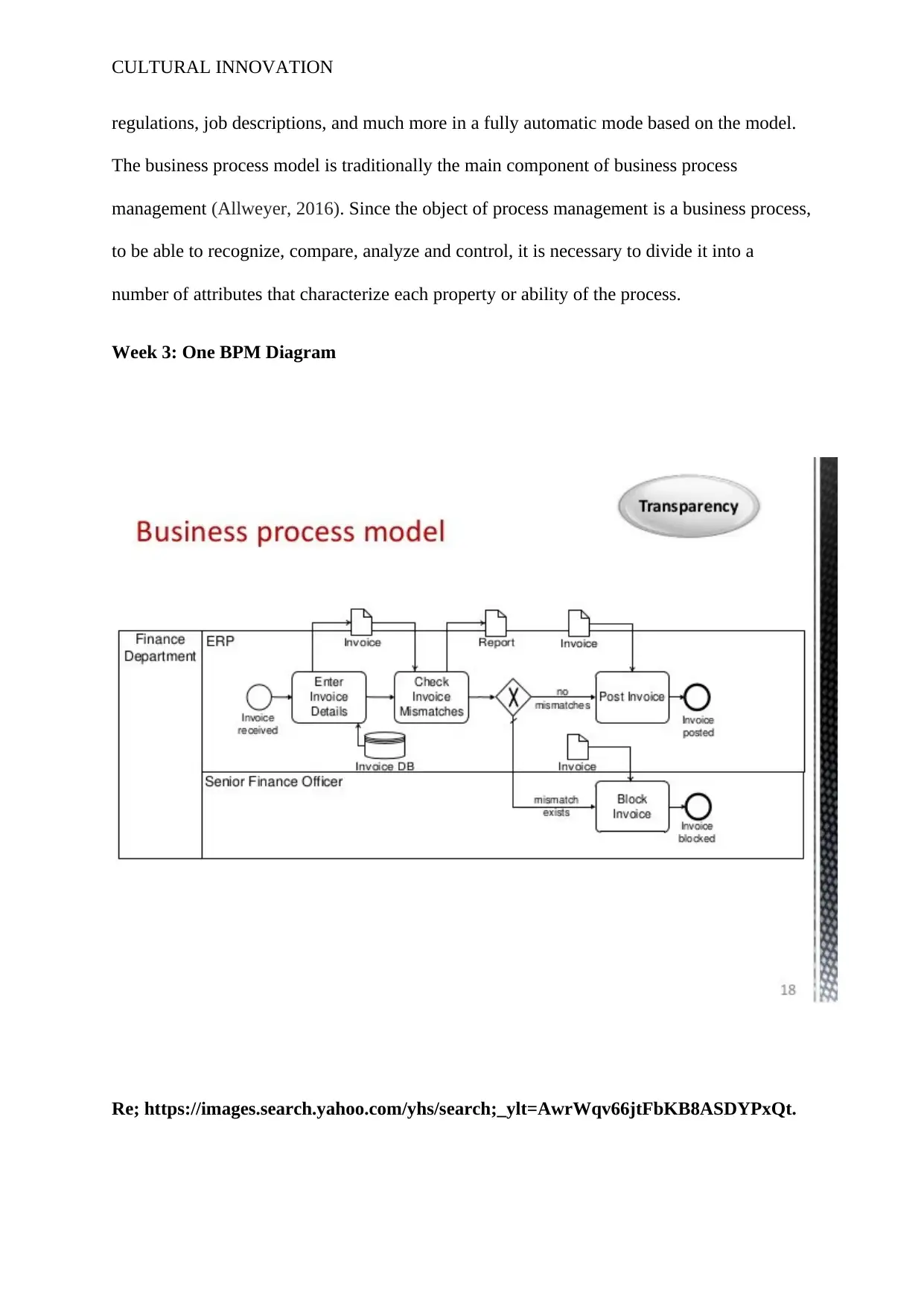
CULTURAL INNOVATION
regulations, job descriptions, and much more in a fully automatic mode based on the model.
The business process model is traditionally the main component of business process
management (Allweyer, 2016). Since the object of process management is a business process,
to be able to recognize, compare, analyze and control, it is necessary to divide it into a
number of attributes that characterize each property or ability of the process.
Week 3: One BPM Diagram
Re; https://images.search.yahoo.com/yhs/search;_ylt=AwrWqv66jtFbKB8ASDYPxQt.
regulations, job descriptions, and much more in a fully automatic mode based on the model.
The business process model is traditionally the main component of business process
management (Allweyer, 2016). Since the object of process management is a business process,
to be able to recognize, compare, analyze and control, it is necessary to divide it into a
number of attributes that characterize each property or ability of the process.
Week 3: One BPM Diagram
Re; https://images.search.yahoo.com/yhs/search;_ylt=AwrWqv66jtFbKB8ASDYPxQt.
⊘ This is a preview!⊘
Do you want full access?
Subscribe today to unlock all pages.

Trusted by 1+ million students worldwide
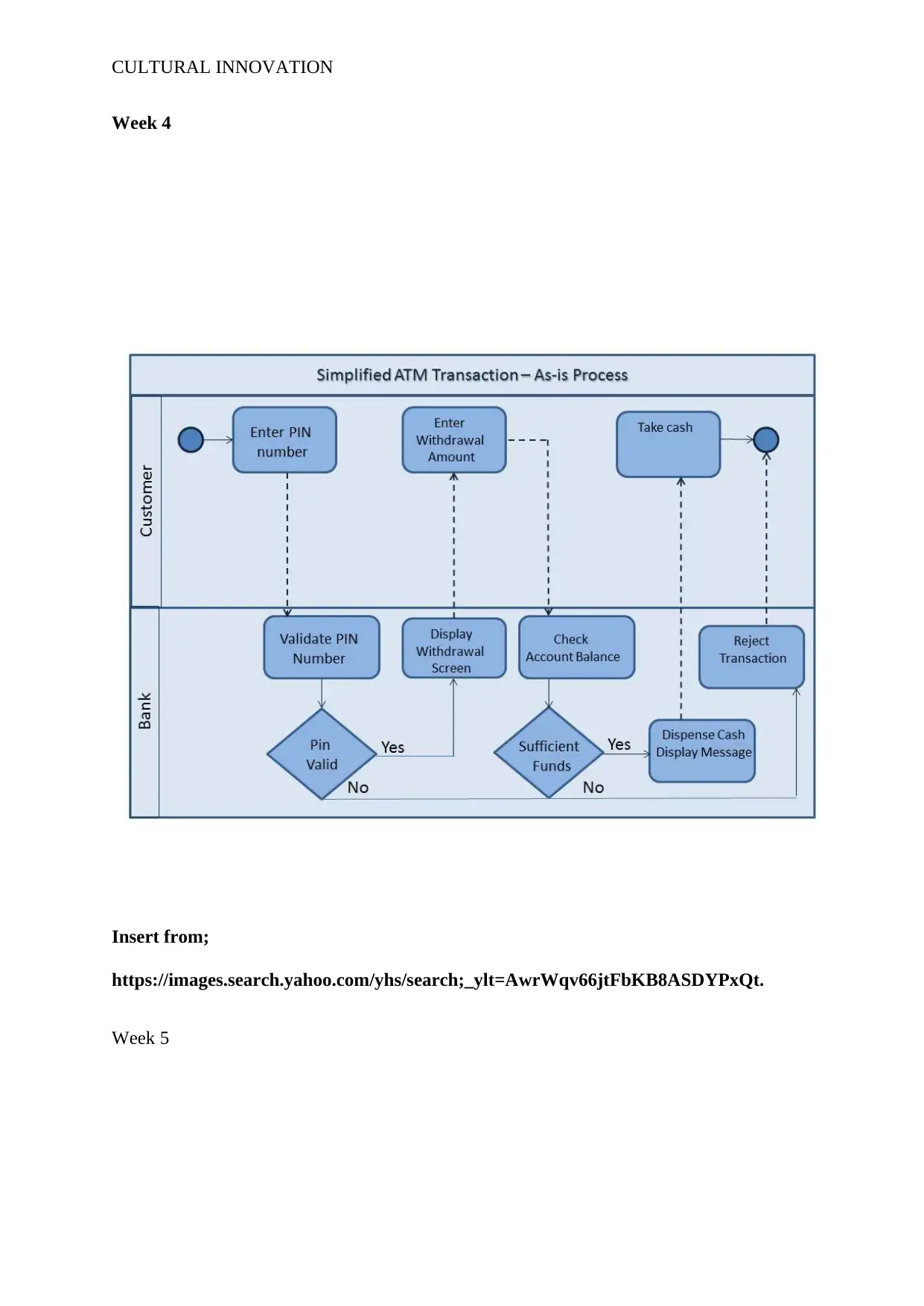
CULTURAL INNOVATION
Week 4
Insert from;
https://images.search.yahoo.com/yhs/search;_ylt=AwrWqv66jtFbKB8ASDYPxQt.
Week 5
Week 4
Insert from;
https://images.search.yahoo.com/yhs/search;_ylt=AwrWqv66jtFbKB8ASDYPxQt.
Week 5
Paraphrase This Document
Need a fresh take? Get an instant paraphrase of this document with our AI Paraphraser
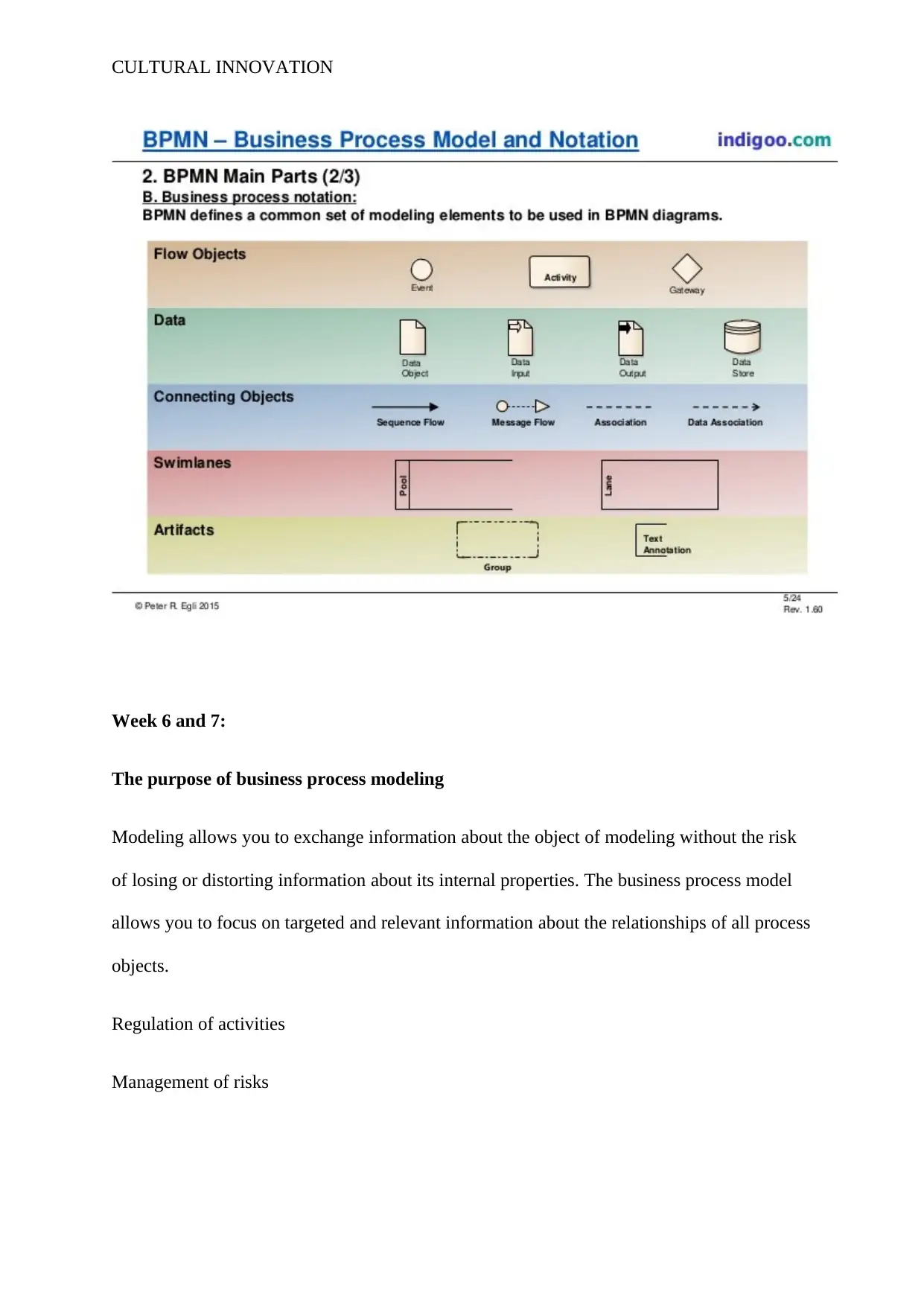
CULTURAL INNOVATION
Week 6 and 7:
The purpose of business process modeling
Modeling allows you to exchange information about the object of modeling without the risk
of losing or distorting information about its internal properties. The business process model
allows you to focus on targeted and relevant information about the relationships of all process
objects.
Regulation of activities
Management of risks
Week 6 and 7:
The purpose of business process modeling
Modeling allows you to exchange information about the object of modeling without the risk
of losing or distorting information about its internal properties. The business process model
allows you to focus on targeted and relevant information about the relationships of all process
objects.
Regulation of activities
Management of risks
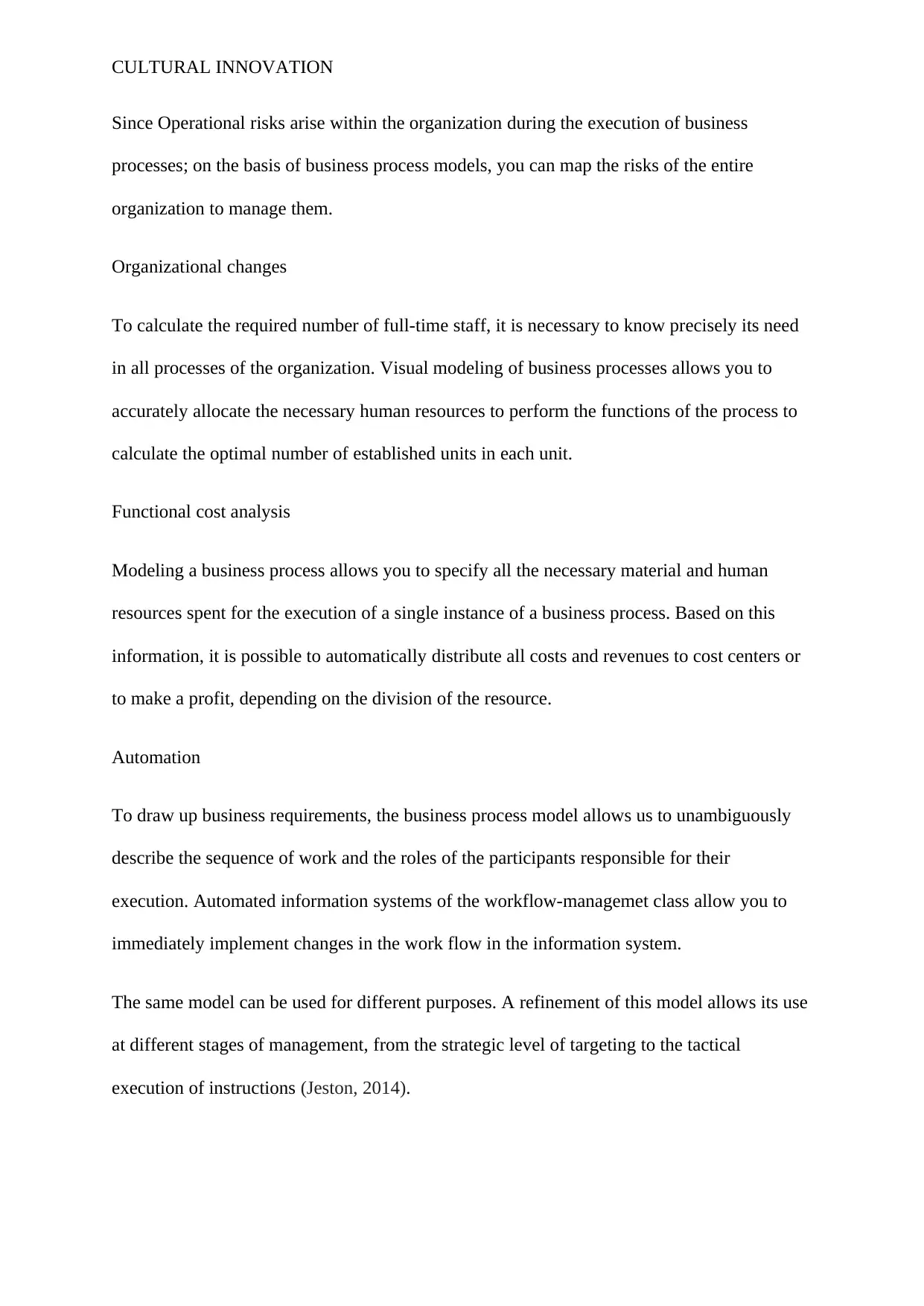
CULTURAL INNOVATION
Since Operational risks arise within the organization during the execution of business
processes; on the basis of business process models, you can map the risks of the entire
organization to manage them.
Organizational changes
To calculate the required number of full-time staff, it is necessary to know precisely its need
in all processes of the organization. Visual modeling of business processes allows you to
accurately allocate the necessary human resources to perform the functions of the process to
calculate the optimal number of established units in each unit.
Functional cost analysis
Modeling a business process allows you to specify all the necessary material and human
resources spent for the execution of a single instance of a business process. Based on this
information, it is possible to automatically distribute all costs and revenues to cost centers or
to make a profit, depending on the division of the resource.
Automation
To draw up business requirements, the business process model allows us to unambiguously
describe the sequence of work and the roles of the participants responsible for their
execution. Automated information systems of the workflow-managemet class allow you to
immediately implement changes in the work flow in the information system.
The same model can be used for different purposes. A refinement of this model allows its use
at different stages of management, from the strategic level of targeting to the tactical
execution of instructions (Jeston, 2014).
Since Operational risks arise within the organization during the execution of business
processes; on the basis of business process models, you can map the risks of the entire
organization to manage them.
Organizational changes
To calculate the required number of full-time staff, it is necessary to know precisely its need
in all processes of the organization. Visual modeling of business processes allows you to
accurately allocate the necessary human resources to perform the functions of the process to
calculate the optimal number of established units in each unit.
Functional cost analysis
Modeling a business process allows you to specify all the necessary material and human
resources spent for the execution of a single instance of a business process. Based on this
information, it is possible to automatically distribute all costs and revenues to cost centers or
to make a profit, depending on the division of the resource.
Automation
To draw up business requirements, the business process model allows us to unambiguously
describe the sequence of work and the roles of the participants responsible for their
execution. Automated information systems of the workflow-managemet class allow you to
immediately implement changes in the work flow in the information system.
The same model can be used for different purposes. A refinement of this model allows its use
at different stages of management, from the strategic level of targeting to the tactical
execution of instructions (Jeston, 2014).
⊘ This is a preview!⊘
Do you want full access?
Subscribe today to unlock all pages.

Trusted by 1+ million students worldwide
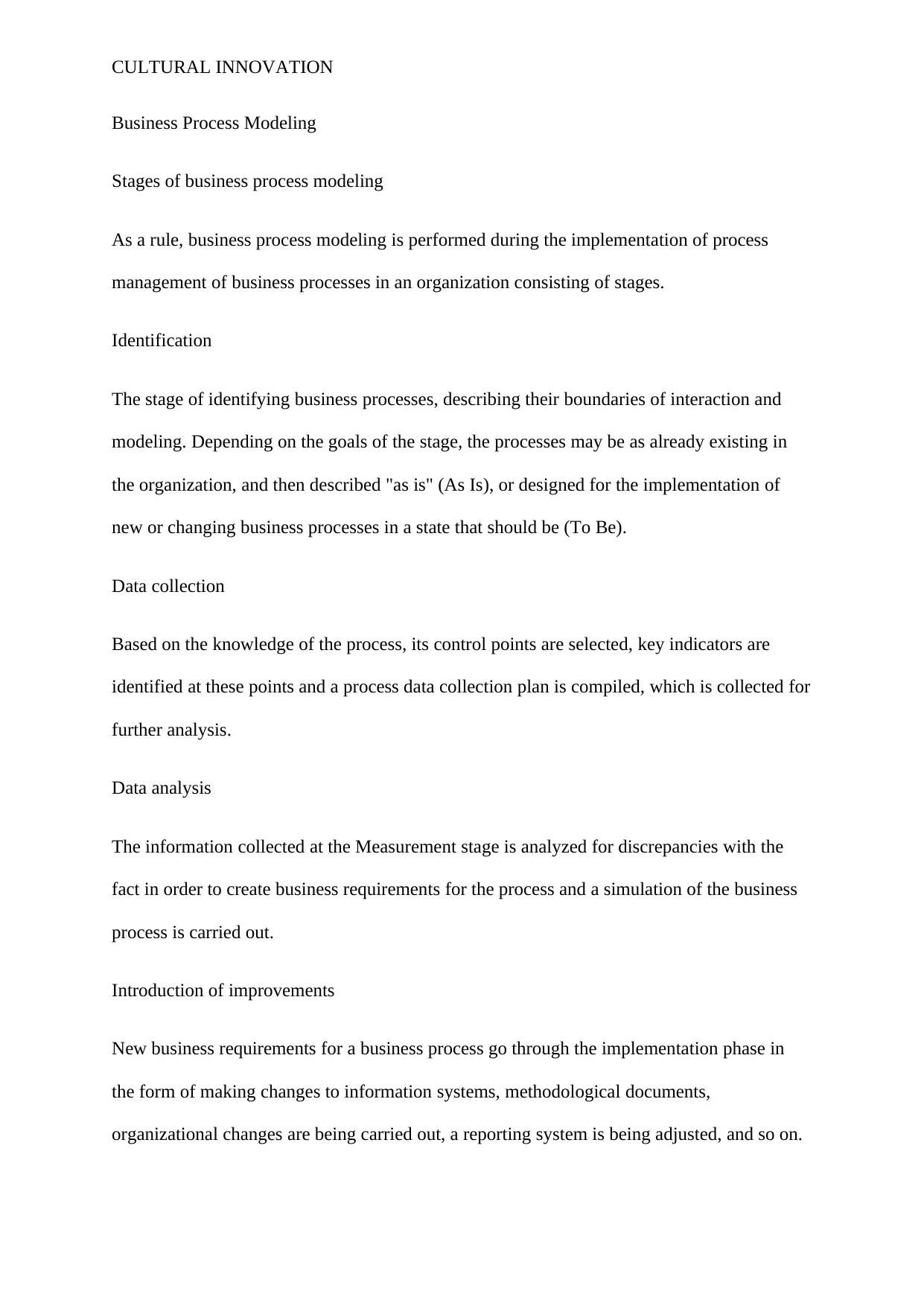
CULTURAL INNOVATION
Business Process Modeling
Stages of business process modeling
As a rule, business process modeling is performed during the implementation of process
management of business processes in an organization consisting of stages.
Identification
The stage of identifying business processes, describing their boundaries of interaction and
modeling. Depending on the goals of the stage, the processes may be as already existing in
the organization, and then described "as is" (As Is), or designed for the implementation of
new or changing business processes in a state that should be (To Be).
Data collection
Based on the knowledge of the process, its control points are selected, key indicators are
identified at these points and a process data collection plan is compiled, which is collected for
further analysis.
Data analysis
The information collected at the Measurement stage is analyzed for discrepancies with the
fact in order to create business requirements for the process and a simulation of the business
process is carried out.
Introduction of improvements
New business requirements for a business process go through the implementation phase in
the form of making changes to information systems, methodological documents,
organizational changes are being carried out, a reporting system is being adjusted, and so on.
Business Process Modeling
Stages of business process modeling
As a rule, business process modeling is performed during the implementation of process
management of business processes in an organization consisting of stages.
Identification
The stage of identifying business processes, describing their boundaries of interaction and
modeling. Depending on the goals of the stage, the processes may be as already existing in
the organization, and then described "as is" (As Is), or designed for the implementation of
new or changing business processes in a state that should be (To Be).
Data collection
Based on the knowledge of the process, its control points are selected, key indicators are
identified at these points and a process data collection plan is compiled, which is collected for
further analysis.
Data analysis
The information collected at the Measurement stage is analyzed for discrepancies with the
fact in order to create business requirements for the process and a simulation of the business
process is carried out.
Introduction of improvements
New business requirements for a business process go through the implementation phase in
the form of making changes to information systems, methodological documents,
organizational changes are being carried out, a reporting system is being adjusted, and so on.
Paraphrase This Document
Need a fresh take? Get an instant paraphrase of this document with our AI Paraphraser
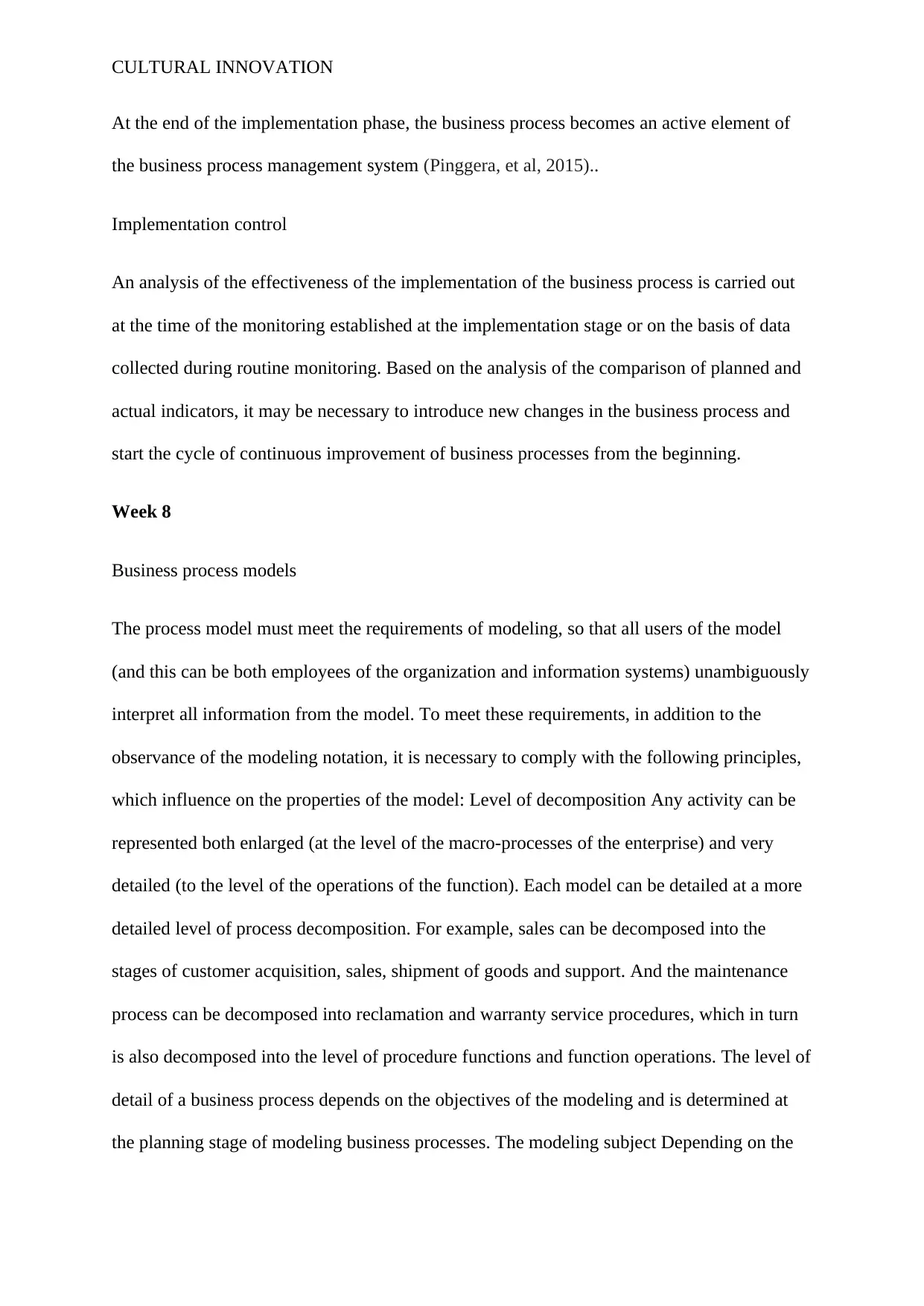
CULTURAL INNOVATION
At the end of the implementation phase, the business process becomes an active element of
the business process management system (Pinggera, et al, 2015)..
Implementation control
An analysis of the effectiveness of the implementation of the business process is carried out
at the time of the monitoring established at the implementation stage or on the basis of data
collected during routine monitoring. Based on the analysis of the comparison of planned and
actual indicators, it may be necessary to introduce new changes in the business process and
start the cycle of continuous improvement of business processes from the beginning.
Week 8
Business process models
The process model must meet the requirements of modeling, so that all users of the model
(and this can be both employees of the organization and information systems) unambiguously
interpret all information from the model. To meet these requirements, in addition to the
observance of the modeling notation, it is necessary to comply with the following principles,
which influence on the properties of the model: Level of decomposition Any activity can be
represented both enlarged (at the level of the macro-processes of the enterprise) and very
detailed (to the level of the operations of the function). Each model can be detailed at a more
detailed level of process decomposition. For example, sales can be decomposed into the
stages of customer acquisition, sales, shipment of goods and support. And the maintenance
process can be decomposed into reclamation and warranty service procedures, which in turn
is also decomposed into the level of procedure functions and function operations. The level of
detail of a business process depends on the objectives of the modeling and is determined at
the planning stage of modeling business processes. The modeling subject Depending on the
At the end of the implementation phase, the business process becomes an active element of
the business process management system (Pinggera, et al, 2015)..
Implementation control
An analysis of the effectiveness of the implementation of the business process is carried out
at the time of the monitoring established at the implementation stage or on the basis of data
collected during routine monitoring. Based on the analysis of the comparison of planned and
actual indicators, it may be necessary to introduce new changes in the business process and
start the cycle of continuous improvement of business processes from the beginning.
Week 8
Business process models
The process model must meet the requirements of modeling, so that all users of the model
(and this can be both employees of the organization and information systems) unambiguously
interpret all information from the model. To meet these requirements, in addition to the
observance of the modeling notation, it is necessary to comply with the following principles,
which influence on the properties of the model: Level of decomposition Any activity can be
represented both enlarged (at the level of the macro-processes of the enterprise) and very
detailed (to the level of the operations of the function). Each model can be detailed at a more
detailed level of process decomposition. For example, sales can be decomposed into the
stages of customer acquisition, sales, shipment of goods and support. And the maintenance
process can be decomposed into reclamation and warranty service procedures, which in turn
is also decomposed into the level of procedure functions and function operations. The level of
detail of a business process depends on the objectives of the modeling and is determined at
the planning stage of modeling business processes. The modeling subject Depending on the
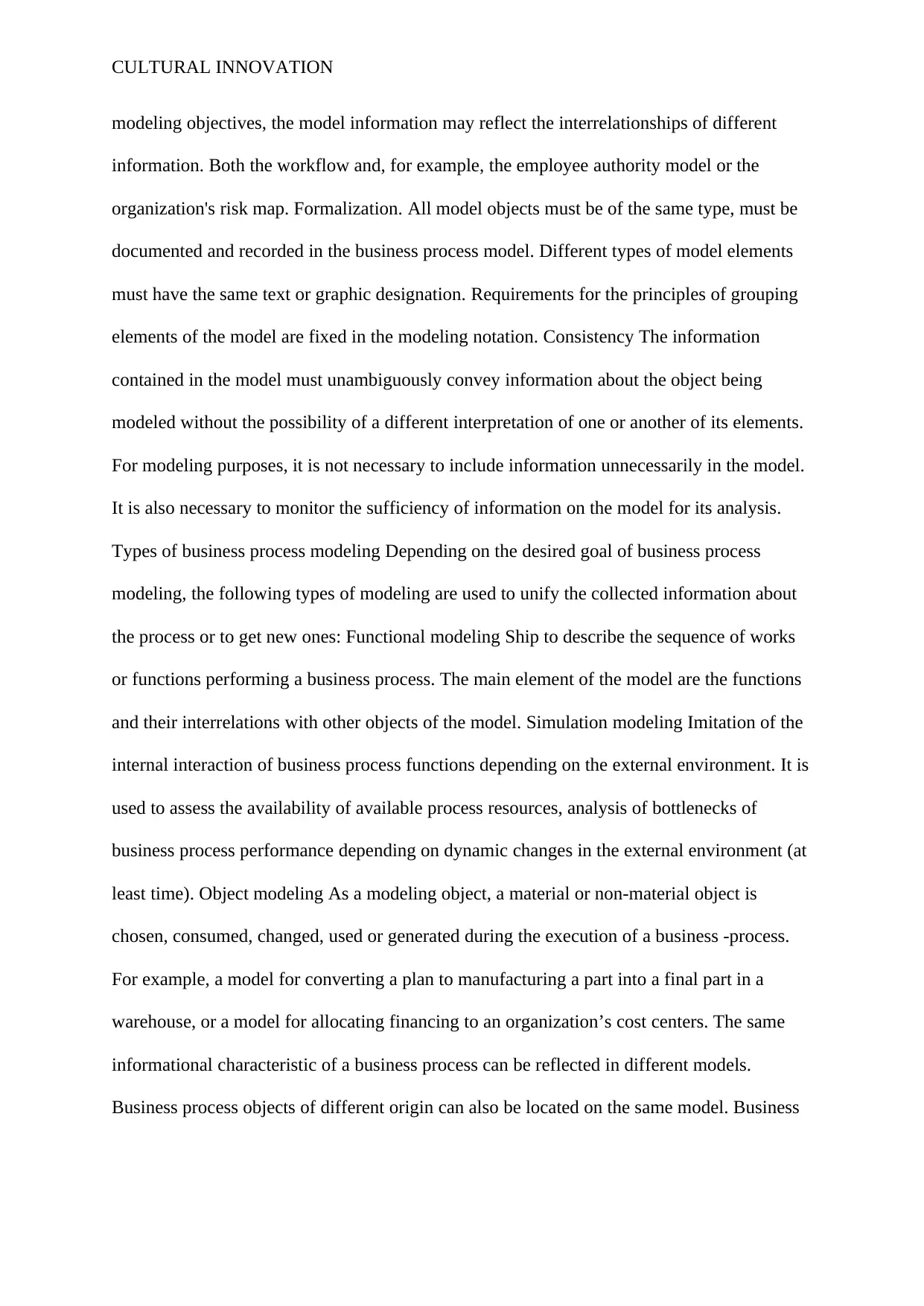
CULTURAL INNOVATION
modeling objectives, the model information may reflect the interrelationships of different
information. Both the workflow and, for example, the employee authority model or the
organization's risk map. Formalization. All model objects must be of the same type, must be
documented and recorded in the business process model. Different types of model elements
must have the same text or graphic designation. Requirements for the principles of grouping
elements of the model are fixed in the modeling notation. Consistency The information
contained in the model must unambiguously convey information about the object being
modeled without the possibility of a different interpretation of one or another of its elements.
For modeling purposes, it is not necessary to include information unnecessarily in the model.
It is also necessary to monitor the sufficiency of information on the model for its analysis.
Types of business process modeling Depending on the desired goal of business process
modeling, the following types of modeling are used to unify the collected information about
the process or to get new ones: Functional modeling Ship to describe the sequence of works
or functions performing a business process. The main element of the model are the functions
and their interrelations with other objects of the model. Simulation modeling Imitation of the
internal interaction of business process functions depending on the external environment. It is
used to assess the availability of available process resources, analysis of bottlenecks of
business process performance depending on dynamic changes in the external environment (at
least time). Object modeling As a modeling object, a material or non-material object is
chosen, consumed, changed, used or generated during the execution of a business -process.
For example, a model for converting a plan to manufacturing a part into a final part in a
warehouse, or a model for allocating financing to an organization’s cost centers. The same
informational characteristic of a business process can be reflected in different models.
Business process objects of different origin can also be located on the same model. Business
modeling objectives, the model information may reflect the interrelationships of different
information. Both the workflow and, for example, the employee authority model or the
organization's risk map. Formalization. All model objects must be of the same type, must be
documented and recorded in the business process model. Different types of model elements
must have the same text or graphic designation. Requirements for the principles of grouping
elements of the model are fixed in the modeling notation. Consistency The information
contained in the model must unambiguously convey information about the object being
modeled without the possibility of a different interpretation of one or another of its elements.
For modeling purposes, it is not necessary to include information unnecessarily in the model.
It is also necessary to monitor the sufficiency of information on the model for its analysis.
Types of business process modeling Depending on the desired goal of business process
modeling, the following types of modeling are used to unify the collected information about
the process or to get new ones: Functional modeling Ship to describe the sequence of works
or functions performing a business process. The main element of the model are the functions
and their interrelations with other objects of the model. Simulation modeling Imitation of the
internal interaction of business process functions depending on the external environment. It is
used to assess the availability of available process resources, analysis of bottlenecks of
business process performance depending on dynamic changes in the external environment (at
least time). Object modeling As a modeling object, a material or non-material object is
chosen, consumed, changed, used or generated during the execution of a business -process.
For example, a model for converting a plan to manufacturing a part into a final part in a
warehouse, or a model for allocating financing to an organization’s cost centers. The same
informational characteristic of a business process can be reflected in different models.
Business process objects of different origin can also be located on the same model. Business
⊘ This is a preview!⊘
Do you want full access?
Subscribe today to unlock all pages.

Trusted by 1+ million students worldwide
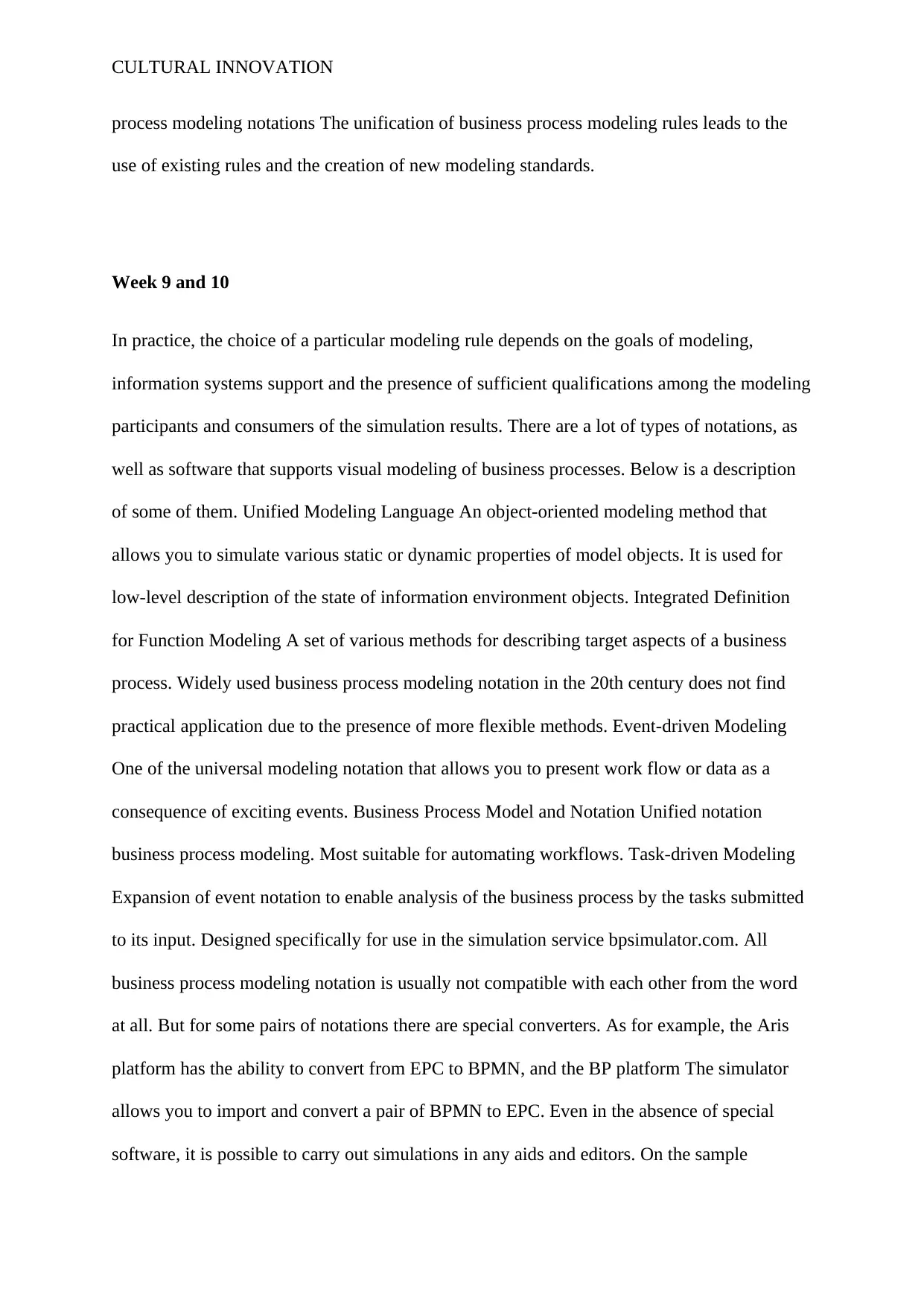
CULTURAL INNOVATION
process modeling notations The unification of business process modeling rules leads to the
use of existing rules and the creation of new modeling standards.
Week 9 and 10
In practice, the choice of a particular modeling rule depends on the goals of modeling,
information systems support and the presence of sufficient qualifications among the modeling
participants and consumers of the simulation results. There are a lot of types of notations, as
well as software that supports visual modeling of business processes. Below is a description
of some of them. Unified Modeling Language An object-oriented modeling method that
allows you to simulate various static or dynamic properties of model objects. It is used for
low-level description of the state of information environment objects. Integrated Definition
for Function Modeling A set of various methods for describing target aspects of a business
process. Widely used business process modeling notation in the 20th century does not find
practical application due to the presence of more flexible methods. Event-driven Modeling
One of the universal modeling notation that allows you to present work flow or data as a
consequence of exciting events. Business Process Model and Notation Unified notation
business process modeling. Most suitable for automating workflows. Task-driven Modeling
Expansion of event notation to enable analysis of the business process by the tasks submitted
to its input. Designed specifically for use in the simulation service bpsimulator.com. All
business process modeling notation is usually not compatible with each other from the word
at all. But for some pairs of notations there are special converters. As for example, the Aris
platform has the ability to convert from EPC to BPMN, and the BP platform The simulator
allows you to import and convert a pair of BPMN to EPC. Even in the absence of special
software, it is possible to carry out simulations in any aids and editors. On the sample
process modeling notations The unification of business process modeling rules leads to the
use of existing rules and the creation of new modeling standards.
Week 9 and 10
In practice, the choice of a particular modeling rule depends on the goals of modeling,
information systems support and the presence of sufficient qualifications among the modeling
participants and consumers of the simulation results. There are a lot of types of notations, as
well as software that supports visual modeling of business processes. Below is a description
of some of them. Unified Modeling Language An object-oriented modeling method that
allows you to simulate various static or dynamic properties of model objects. It is used for
low-level description of the state of information environment objects. Integrated Definition
for Function Modeling A set of various methods for describing target aspects of a business
process. Widely used business process modeling notation in the 20th century does not find
practical application due to the presence of more flexible methods. Event-driven Modeling
One of the universal modeling notation that allows you to present work flow or data as a
consequence of exciting events. Business Process Model and Notation Unified notation
business process modeling. Most suitable for automating workflows. Task-driven Modeling
Expansion of event notation to enable analysis of the business process by the tasks submitted
to its input. Designed specifically for use in the simulation service bpsimulator.com. All
business process modeling notation is usually not compatible with each other from the word
at all. But for some pairs of notations there are special converters. As for example, the Aris
platform has the ability to convert from EPC to BPMN, and the BP platform The simulator
allows you to import and convert a pair of BPMN to EPC. Even in the absence of special
software, it is possible to carry out simulations in any aids and editors. On the sample
Paraphrase This Document
Need a fresh take? Get an instant paraphrase of this document with our AI Paraphraser
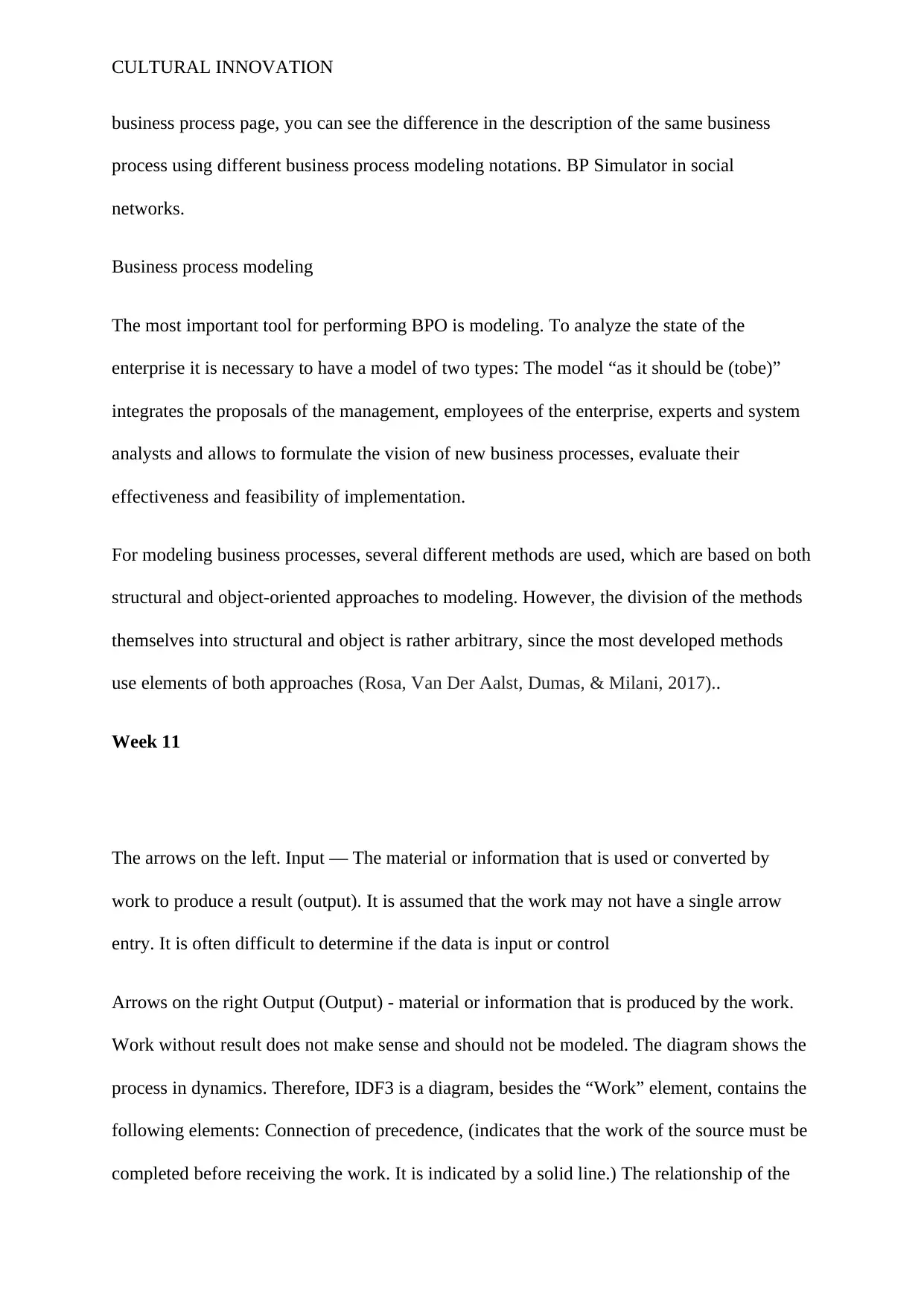
CULTURAL INNOVATION
business process page, you can see the difference in the description of the same business
process using different business process modeling notations. BP Simulator in social
networks.
Business process modeling
The most important tool for performing BPO is modeling. To analyze the state of the
enterprise it is necessary to have a model of two types: The model “as it should be (tobe)”
integrates the proposals of the management, employees of the enterprise, experts and system
analysts and allows to formulate the vision of new business processes, evaluate their
effectiveness and feasibility of implementation.
For modeling business processes, several different methods are used, which are based on both
structural and object-oriented approaches to modeling. However, the division of the methods
themselves into structural and object is rather arbitrary, since the most developed methods
use elements of both approaches (Rosa, Van Der Aalst, Dumas, & Milani, 2017)..
Week 11
The arrows on the left. Input — The material or information that is used or converted by
work to produce a result (output). It is assumed that the work may not have a single arrow
entry. It is often difficult to determine if the data is input or control
Arrows on the right Output (Output) - material or information that is produced by the work.
Work without result does not make sense and should not be modeled. The diagram shows the
process in dynamics. Therefore, IDF3 is a diagram, besides the “Work” element, contains the
following elements: Connection of precedence, (indicates that the work of the source must be
completed before receiving the work. It is indicated by a solid line.) The relationship of the
business process page, you can see the difference in the description of the same business
process using different business process modeling notations. BP Simulator in social
networks.
Business process modeling
The most important tool for performing BPO is modeling. To analyze the state of the
enterprise it is necessary to have a model of two types: The model “as it should be (tobe)”
integrates the proposals of the management, employees of the enterprise, experts and system
analysts and allows to formulate the vision of new business processes, evaluate their
effectiveness and feasibility of implementation.
For modeling business processes, several different methods are used, which are based on both
structural and object-oriented approaches to modeling. However, the division of the methods
themselves into structural and object is rather arbitrary, since the most developed methods
use elements of both approaches (Rosa, Van Der Aalst, Dumas, & Milani, 2017)..
Week 11
The arrows on the left. Input — The material or information that is used or converted by
work to produce a result (output). It is assumed that the work may not have a single arrow
entry. It is often difficult to determine if the data is input or control
Arrows on the right Output (Output) - material or information that is produced by the work.
Work without result does not make sense and should not be modeled. The diagram shows the
process in dynamics. Therefore, IDF3 is a diagram, besides the “Work” element, contains the
following elements: Connection of precedence, (indicates that the work of the source must be
completed before receiving the work. It is indicated by a solid line.) The relationship of the
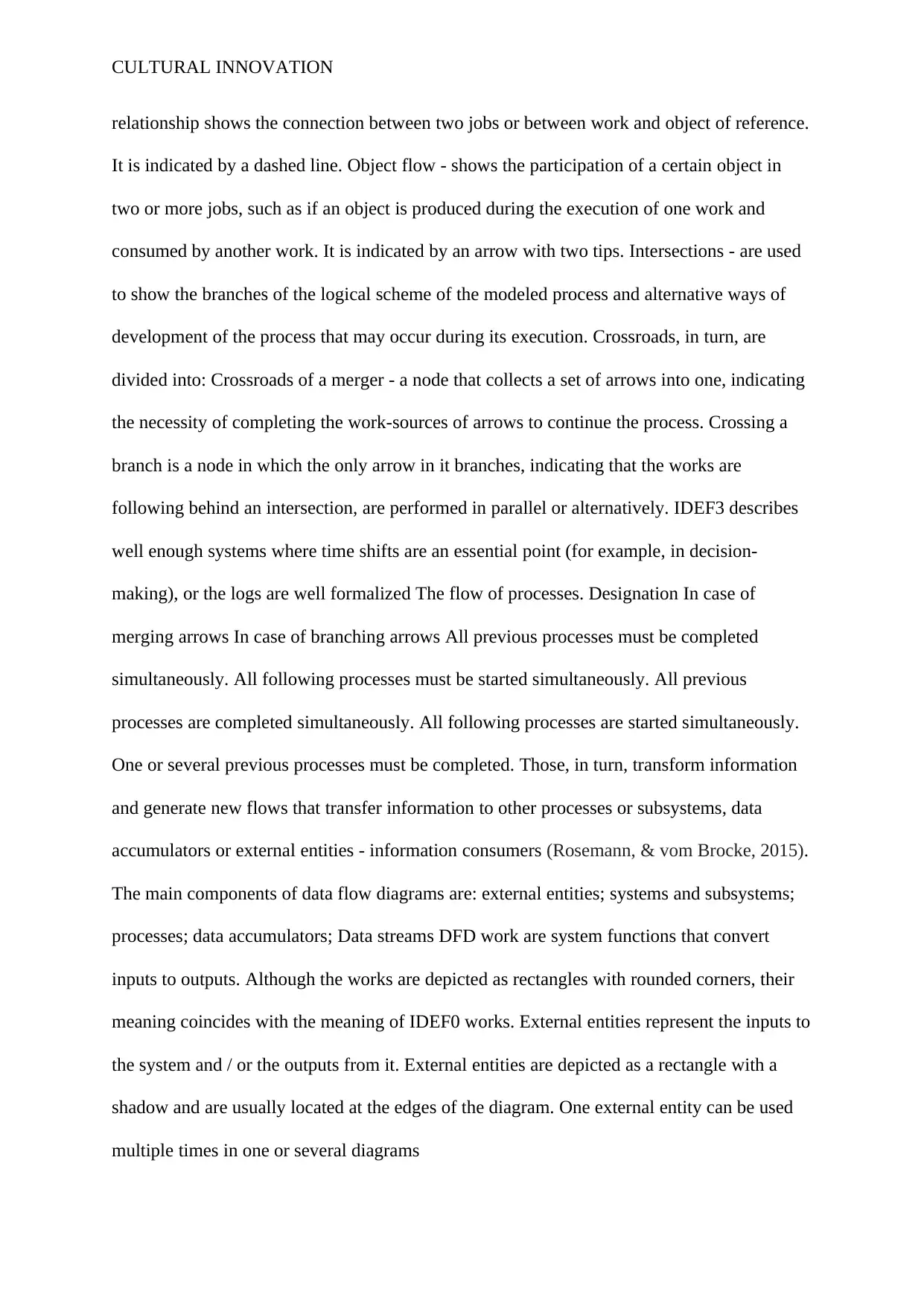
CULTURAL INNOVATION
relationship shows the connection between two jobs or between work and object of reference.
It is indicated by a dashed line. Object flow - shows the participation of a certain object in
two or more jobs, such as if an object is produced during the execution of one work and
consumed by another work. It is indicated by an arrow with two tips. Intersections - are used
to show the branches of the logical scheme of the modeled process and alternative ways of
development of the process that may occur during its execution. Crossroads, in turn, are
divided into: Crossroads of a merger - a node that collects a set of arrows into one, indicating
the necessity of completing the work-sources of arrows to continue the process. Crossing a
branch is a node in which the only arrow in it branches, indicating that the works are
following behind an intersection, are performed in parallel or alternatively. IDEF3 describes
well enough systems where time shifts are an essential point (for example, in decision-
making), or the logs are well formalized The flow of processes. Designation In case of
merging arrows In case of branching arrows All previous processes must be completed
simultaneously. All following processes must be started simultaneously. All previous
processes are completed simultaneously. All following processes are started simultaneously.
One or several previous processes must be completed. Those, in turn, transform information
and generate new flows that transfer information to other processes or subsystems, data
accumulators or external entities - information consumers (Rosemann, & vom Brocke, 2015).
The main components of data flow diagrams are: external entities; systems and subsystems;
processes; data accumulators; Data streams DFD work are system functions that convert
inputs to outputs. Although the works are depicted as rectangles with rounded corners, their
meaning coincides with the meaning of IDEF0 works. External entities represent the inputs to
the system and / or the outputs from it. External entities are depicted as a rectangle with a
shadow and are usually located at the edges of the diagram. One external entity can be used
multiple times in one or several diagrams
relationship shows the connection between two jobs or between work and object of reference.
It is indicated by a dashed line. Object flow - shows the participation of a certain object in
two or more jobs, such as if an object is produced during the execution of one work and
consumed by another work. It is indicated by an arrow with two tips. Intersections - are used
to show the branches of the logical scheme of the modeled process and alternative ways of
development of the process that may occur during its execution. Crossroads, in turn, are
divided into: Crossroads of a merger - a node that collects a set of arrows into one, indicating
the necessity of completing the work-sources of arrows to continue the process. Crossing a
branch is a node in which the only arrow in it branches, indicating that the works are
following behind an intersection, are performed in parallel or alternatively. IDEF3 describes
well enough systems where time shifts are an essential point (for example, in decision-
making), or the logs are well formalized The flow of processes. Designation In case of
merging arrows In case of branching arrows All previous processes must be completed
simultaneously. All following processes must be started simultaneously. All previous
processes are completed simultaneously. All following processes are started simultaneously.
One or several previous processes must be completed. Those, in turn, transform information
and generate new flows that transfer information to other processes or subsystems, data
accumulators or external entities - information consumers (Rosemann, & vom Brocke, 2015).
The main components of data flow diagrams are: external entities; systems and subsystems;
processes; data accumulators; Data streams DFD work are system functions that convert
inputs to outputs. Although the works are depicted as rectangles with rounded corners, their
meaning coincides with the meaning of IDEF0 works. External entities represent the inputs to
the system and / or the outputs from it. External entities are depicted as a rectangle with a
shadow and are usually located at the edges of the diagram. One external entity can be used
multiple times in one or several diagrams
⊘ This is a preview!⊘
Do you want full access?
Subscribe today to unlock all pages.

Trusted by 1+ million students worldwide
1 out of 13
Related Documents
Your All-in-One AI-Powered Toolkit for Academic Success.
+13062052269
info@desklib.com
Available 24*7 on WhatsApp / Email
![[object Object]](/_next/static/media/star-bottom.7253800d.svg)
Unlock your academic potential
Copyright © 2020–2025 A2Z Services. All Rights Reserved. Developed and managed by ZUCOL.




